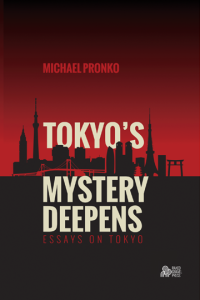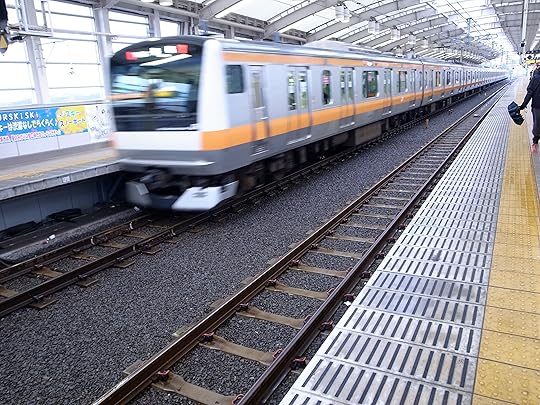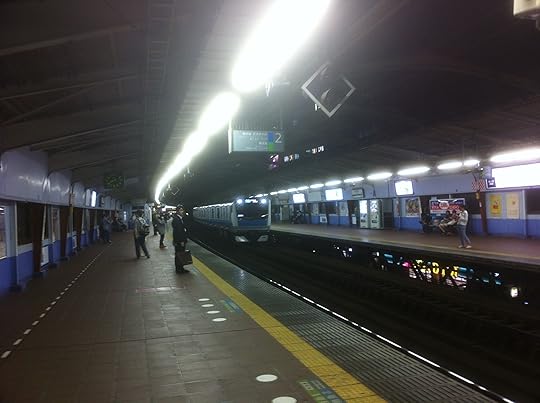Michael Pronko's Blog, page 15
July 9, 2016
2016 THE KINDLE BOOK REVIEW
June 30, 2016
Five Star Review from For Novel Lovers
Tokyo’s Mystery Deepens by Michael Pronko

Book Review
Title: Tokyo’s Mystery Deepens
Author: Michael Pronko
Genre: Non-fictional/Slice of Life/Essay
Rating: *****
Review: I wanted to say before I begin this review is going to be slightly longer than some of the other ones I do because this book is a collection of essays on life in Tokyo and therefore cannot be reviewed using the same process I use for the average novel.
I loved this book before I even opened it because it is written about life in Japan, Tokyo in particular and it’s a place I have always wanted to visit/live/experience. I loved the introduction as Michael Pronko living in Japan still feels like a tourist at times because of the mysterious and slightly confusing nature of life in Japan. And these sorts of introductions are the best because it gives you a more rounded sense of the author before the essays start which is needed otherwise they can feel very clinical and detached.
The books itself is split into 4 parts, the first being the Essentials of Tokyo-ism. This part focuses around little things that Tokyoites do like apologizing a lot. I loved that chapter because it shows that foreigners can adjust to a different way of life. Apologizing in the UK is mainly used for higher transgressions, for example standing on someone’s foot on the train, in the UK whether we did the stepping or got stepped on we would ignore it but the Japanese are very quick to apologize in this situation to anticipate and prevent larger more serious problems which is something other countries should adopt.
I also liked the fact Michael Pronko feels extremely protective of “his city” even though he’s a newcomer compared to most people and he doesn’t really like the fact he runs into a lot of foreigners. It almost feels like he was born and raised there.
Michael Pronko talks about the cultural and social norms in Tokyo and Japan in general, as how the different from the Western world i.e. America and the UK. My favourite norm is the surgical masks we see a lot of Japanese people wearing and how it offers not just protection for germs but offers a way of distancing oneself from everyday stresses like work and social interaction.
I loved his writing style its personal, interesting and at the same time informative and formal written. It’s fun, upbeat and never boring even when talking about the most mundane things like street lighting, bank form etc.
My favourite chapter was Testimony in Red purely because of the way Pronko talks about hankos or little red rubber stamps used instead of signatures. I loved the enthusiasm and panic he feels filling out forms and signing like an American and having to fill in the same form several times. I just loved how it is something so mundane yet it makes him feel so special and a important, it conveys an ultimate sense of wonder of our everyday lives that we normally forget in our autonomy.
I also enjoyed the way he talked about the newer generations losing the cultural norms of the previous generation and their gestures becoming more western. An example of this is the new generation laugh and smile more openly where the previous generation would indicate these emotions with slight hand and head gestures.
I really loved being about to learn more about the cultural and social side of my favourite country in the world, some of the things Pronko talks about like the hanko, slight hand gestures and social awareness I never knew before but reading this book has helped me understand better things that I found strange about Japan. When reading this you understand that their social norms seem strange from a western point of view but ours are just as strange to them.
The second section of the book focuses on the society more as a whole although still looking at small things like the noise level of the city compared to other, questionnaires given out almost everywhere you go and how these fit in and what purpose they serve. I like the fact we are looking at Tokyo through the eyes of a foreigner (technically) although he has adjusted to life in a city whose cultural and societal norms are almost completely backward to the western world. I found it a surprisingly refreshing new insight to Eastern society.
Also in the section Pronko also briefly talks about Japanese politics, infrastructure and technology and they effect and invade everyday life, meaning the day doesn’t quiet or slow down until the evening. And reading through this section you can build a more detailed picture of the city and city life in Tokyo in your mind, you can see the new fantasy-like skyscrapers, hear the noise and almost feel the beating heart of the city.
Pronko also talks about saving face in a way. He talks about how Tokyoites are constantly trying to present the perfect image by having the right clothes, hair and make-up. They focus highly on their outward appearance and social etiquette rather than their own personal opinions and preferences. Which is completely different to the UK where I live as we westerners pride ourselves on individuality rather than sartorial homogeneity.
I also loved the fact he pointed out Tokyo unlike most cities can be divided into male and females halves, and these halves live, work and survive parallel with each other but hardly even interact. I loved this comparison as he sees mother/daughter and father/son although they may be friends not direct relations. The only time you really see a male/female pairing is if they are a couple i.e. girlfriend/boyfriend or husband/wife you don’t really see F/M pairing otherwise – the only exception to this would be colleague outings.
I admired the way he talks about little things and how they become big staples in the everyday life of a Tokyoite, like smoking (mainly circumstantial) and energy/power drinks and how almost every person in Tokyo can use these things on a daily basis, especially the energy drinks. I also respect the amount of work Pronko must have gone through to create this book and give us the reader just a glimpse into the mysterious world of the Orient, that is as fragile and wondrous as it has always been, and how it refuses to conform to the ever changing world.
Despite refusing to conform to the global changes Japan goes above and beyond becoming a futuristic fantasy-like city but in pursuing this they are beginning to lose their own history. Once this history is lost it can never be regained.
One of my favourite topics was how in Tokyo the pursuit and acquisition of knowledge has become the ultimate guide determined one’s rank and position in society. Delving deeper into this he also talks about how the pursuit has taken away the pleasure and wisdom gaining from slow absorbing (not cram) learning.
The third part entitled Seasons in the Labyrinth was one of my favourites because it brings a sense of warmth to the soul. I loved the way Pronko talks about the temples, various festivals, the emergence of the cherry blossom in the spring and even allergies, he does it in such a way that absolutely everything – even a man sneezing on the train, fireworks – is so wondrous that it cannot be ignored.
Reading this section also made me rather sad as I realised I have a huge longing to visit Japan even if for a short while but I’ll probably never see it with my own eyes. As someone with little formal education and years of experience in dead end jobs I doubt I’ll ever have the opportunities to witness the mysteries and life in the Orient. But I also feel happy and proud in a way for the author for getting there, living there and understanding the cultural wonders of such a impressive place on this ever-shrinking Earth.
The final section of this book talks about life deep within the beating heart of the city. When reading this section you can feel the book drawing to a close and you don’t want it to end, you want just one more page to envelop more of these wonders. The one thing I would have like in this book would have been a few pictures just to solidify some of the points Michael Pronko was making especially when he talks about the changing seasons relating to the cherry blossoms and oak trees.
Michael Pronko is an amazing writer. He can make you see and feel something in this case a city, in a way you have never experienced before or will again. I own two of his books, both of which he personally sent to me and I can’t wait to read more. Even though is books are collections of essays and I don’t normally read non-fiction I can’t get enough.
I do believe though if Pronko wrote a fictional novel with the same passion and devotion as this one, it would be an absolutely astounding read.
Five Star Review
Tokyo’s Mystery Deepens by Michael Pronko
Book Review
Title: Tokyo’s Mystery Deepens
Author: Michael Pronko
Genre: Non-fictional/Slice of Life/Essay
Rating: *****
Review: I wanted to say before I begin this review is going to be slightly longer than some of the other ones I do because this book is a collection of essays on life in Tokyo and therefore cannot be reviewed using the same process I use for the average novel.
I loved this book before I even opened it because it is written about life in Japan, Tokyo in particular and it’s a place I have always wanted to visit/live/experience. I loved the introduction as Michael Pronko living in Japan still feels like a tourist at times because of the mysterious and slightly confusing nature of life in Japan. And these sorts of introductions are the best because it gives you a more rounded sense of the author before the essays start which is needed otherwise they can feel very clinical and detached.
The books itself is split into 4 parts, the first being the Essentials of Tokyo-ism. This part focuses around little things that Tokyoites do like apologizing a lot. I loved that chapter because it shows that foreigners can adjust to a different way of life. Apologizing in the UK is mainly used for higher transgressions, for example standing on someone’s foot on the train, in the UK whether we did the stepping or got stepped on we would ignore it but the Japanese are very quick to apologize in this situation to anticipate and prevent larger more serious problems which is something other countries should adopt.
I also liked the fact Michael Pronko feels extremely protective of “his city” even though he’s a newcomer compared to most people and he doesn’t really like the fact he runs into a lot of foreigners. It almost feels like he was born and raised there.
Michael Pronko talks about the cultural and social norms in Tokyo and Japan in general, as how the different from the Western world i.e. America and the UK. My favourite norm is the surgical masks we see a lot of Japanese people wearing and how it offers not just protection for germs but offers a way of distancing oneself from everyday stresses like work and social interaction.
I loved his writing style its personal, interesting and at the same time informative and formal written. It’s fun, upbeat and never boring even when talking about the most mundane things like street lighting, bank form etc.
My favourite chapter was Testimony in Red purely because of the way Pronko talks about hankos or little red rubber stamps used instead of signatures. I loved the enthusiasm and panic he feels filling out forms and signing like an American and having to fill in the same form several times. I just loved how it is something so mundane yet it makes him feel so special and a important, it conveys an ultimate sense of wonder of our everyday lives that we normally forget in our autonomy.
I also enjoyed the way he talked about the newer generations losing the cultural norms of the previous generation and their gestures becoming more western. An example of this is the new generation laugh and smile more openly where the previous generation would indicate these emotions with slight hand and head gestures.
I really loved being about to learn more about the cultural and social side of my favourite country in the world, some of the things Pronko talks about like the hanko, slight hand gestures and social awareness I never knew before but reading this book has helped me understand better things that I found strange about Japan. When reading this you understand that their social norms seem strange from a western point of view but ours are just as strange to them.
The second section of the book focuses on the society more as a whole although still looking at small things like the noise level of the city compared to other, questionnaires given out almost everywhere you go and how these fit in and what purpose they serve. I like the fact we are looking at Tokyo through the eyes of a foreigner (technically) although he has adjusted to life in a city whose cultural and societal norms are almost completely backward to the western world. I found it a surprisingly refreshing new insight to Eastern society.
Also in the section Pronko also briefly talks about Japanese politics, infrastructure and technology and they effect and invade everyday life, meaning the day doesn’t quiet or slow down until the evening. And reading through this section you can build a more detailed picture of the city and city life in Tokyo in your mind, you can see the new fantasy-like skyscrapers, hear the noise and almost feel the beating heart of the city.
Pronko also talks about saving face in a way. He talks about how Tokyoites are constantly trying to present the perfect image by having the right clothes, hair and make-up. They focus highly on their outward appearance and social etiquette rather than their own personal opinions and preferences. Which is completely different to the UK where I live as we westerners pride ourselves on individuality rather than sartorial homogeneity.
I also loved the fact he pointed out Tokyo unlike most cities can be divided into male and females halves, and these halves live, work and survive parallel with each other but hardly even interact. I loved this comparison as he sees mother/daughter and father/son although they may be friends not direct relations. The only time you really see a male/female pairing is if they are a couple i.e. girlfriend/boyfriend or husband/wife you don’t really see F/M pairing otherwise – the only exception to this would be colleague outings.
I admired the way he talks about little things and how they become big staples in the everyday life of a Tokyoite, like smoking (mainly circumstantial) and energy/power drinks and how almost every person in Tokyo can use these things on a daily basis, especially the energy drinks. I also respect the amount of work Pronko must have gone through to create this book and give us the reader just a glimpse into the mysterious world of the Orient, that is as fragile and wondrous as it has always been, and how it refuses to conform to the ever changing world.
Despite refusing to conform to the global changes Japan goes above and beyond becoming a futuristic fantasy-like city but in pursuing this they are beginning to lose their own history. Once this history is lost it can never be regained.
One of my favourite topics was how in Tokyo the pursuit and acquisition of knowledge has become the ultimate guide determined one’s rank and position in society. Delving deeper into this he also talks about how the pursuit has taken away the pleasure and wisdom gaining from slow absorbing (not cram) learning.
The third part entitled Seasons in the Labyrinth was one of my favourites because it brings a sense of warmth to the soul. I loved the way Pronko talks about the temples, various festivals, the emergence of the cherry blossom in the spring and even allergies, he does it in such a way that absolutely everything – even a man sneezing on the train, fireworks – is so wondrous that it cannot be ignored.
Reading this section also made me rather sad as I realised I have a huge longing to visit Japan even if for a short while but I’ll probably never see it with my own eyes. As someone with little formal education and years of experience in dead end jobs I doubt I’ll ever have the opportunities to witness the mysteries and life in the Orient. But I also feel happy and proud in a way for the author for getting there, living there and understanding the cultural wonders of such a impressive place on this ever-shrinking Earth.
The final section of this book talks about life deep within the beating heart of the city. When reading this section you can feel the book drawing to a close and you don’t want it to end, you want just one more page to envelop more of these wonders. The one thing I would have like in this book would have been a few pictures just to solidify some of the points Michael Pronko was making especially when he talks about the changing seasons relating to the cherry blossoms and oak trees.
Michael Pronko is an amazing writer. He can make you see and feel something in this case a city, in a way you have never experienced before or will again. I own two of his books, both of which he personally sent to me and I can’t wait to read more. Even though is books are collections of essays and I don’t normally read non-fiction I can’t get enough.
I do believe though if Pronko wrote a fictional novel with the same passion and devotion as this one, it would be an absolutely astounding read.
May 26, 2016
Another Award
Finalist Award

Finalist “Travel: Guides & Essays” 2016 International Book Awards
May 20, 2016
Two Boys on the Train
Two boys bumped me as I was reading on the train last week. They were about nine or ten, with no school or shopping bag, in sports clothes, on the way home, I guessed, from soccer practice at their school sports ground a few stations away. Their giggling and push-pulling each other was punctuated by glances at one of the advertisements, or maybe the video screen, that cover the eye space of Tokyo trains.
I was tired and not in a people-watching mood, but I watched them anyway, without turning to see the ad, musing on how different their path home was from mine as a boy. My route home from school ran along a creek, which we called “the creek,” and then meandered along lazy sidewalks, over a small footbridge, and past sycamore trees and wide lawns.
I started to watch as they whispered to each other, looking up and back. Tokyo trains are swathed in advertisements printed on paper about the size of a big computer screen. Beer, books, hotlines, tax info, shampoo, snacks and everything that can be sold is slapped on paper and slipped on racks encircling the visual space of every train. If you glance around, there is no escape.

On my way home, we loved to take the sycamore tree seed balls, smash them open, and jam them down the shirt of an unsuspecting classmate. They itched like hell. Or at least we thought they did. And then we wrestled, fought or played the same “grab-ass” these two Tokyo boys were playing on the train. Snowball fights across the iced-over creek were the highlight of winters.
At one point, when we were about eleven or twelve, we started having battles with the girls. They always won, since they were bigger than us at that point. Somehow they managed to get home, fill up water balloons, snatch bananas to smear in our hair, and run back to where the roads diverged before we got there. We sometimes had to go around the long way to avoid them.
That could all happen because we walked home in a glorious child-only world, far from the eyes of adults. Cars drove by, but no one we knew. We were free for the twenty dawdling minutes, or even the hour if we got into things, that it took us to walk home. We had space, time, snow, sycamore balls and other kids.
The two Tokyo boys, though, seemed to me trapped on the train home. They kept scuffling and drawing glances from all the adults tired from work and in no mood for their fooling around if it meant being bumped into. Finally, I turned to look at the ad the boys kept glancing up at and whispering about. It was for Playboy magazine.
The ad was like all of them: full-breasted women in bikinis, a side bar of other women’s cleavages, their faces smiling or pouting or faking innocence. All around them was text in splashy fonts trumpeting the writing. It was not much in this day and age of Internet porn.
The boys, though, could not get their eyes off the ad, looking and whispering, whispering and looking. I strained to hear what they said, but they spoke too softly. But I knew what they were saying. I said the same things myself.
The first time I saw Playboy was on my path home, too. A friend from school had stolen one of his father’s copies and hidden it in a storm drainpipe that fed into the creek. I was too afraid to go all the way through the pipe to the other end where you could be reborn onto a street gutter a block away. But the classmate who stole the Playboy went all the way through often on dares and bets to pick up pocket change.
He went into the drainpipe and retrieved the magazine that afternoon and brought it out to share without charging us. We huddled on the rocks on the bank of the creek and looked at the images of women the Playboy editors concocted for us. It was a rare and momentous event that I remember nearly forty some years later.
Were these boys’ reactions the same as mine flipping those pages in awe with the other guys by the creek? Did these two Tokyo boys feel the same stirrings while sneaking glances up at an advertisement they were still too short to even reach? Surrounded by tired commuters watching them knowingly, disgusted or indifferent, was that boyhood glance, as naïve, curious and embarrassing, as desired, startling and rare, for those boys as it had been for me?
Though we were separated by decades, cultures, languages and surroundings, it startled me to re-confront the boyish interest in sex and women’s bodies. So far away from where I had seen that first nude was the exact same magazine, spinning out the exact same headlines, same attitudes, and same poses. Even the word “nude” is used in Japanese (pronounced “new-dough”).
My sycamores and creek could not be more different from a train car and platforms, the 1960s from the 2010s, a calm suburb from a thriving city, wide spaces from cramped trains. Culture, language, education, upbringing was nothing alike.
Yet, in the middle of both, was the same falsely-tantalizing but still awe-inspiring representation of the female body. It had fallen on top of them, as with me, before we were even conscious of it, and the need to look rose up, no doubt, from inside us with the same yearnings and confusions.
When they ran out the door at their station, I was left wondering why our cultures, so thorough at mediating and shaping our experiences, couldn’t have given us the first view of something so magnificent in any better way.
May 21, 2016

May 7, 2016
gold honoree benjamin franklin awards

Gold Honoree Benjamin Franklin Digital Awards (Independent Book Publishers Association)








